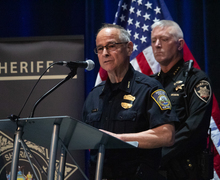‘First Man’ provides an intensely personal look at Apollo 11, man’s mission to the moon
The Apollo 11 mission put American men on the moon. It was one small step for man, but it was a giant sacrifice for the families of the astronauts involved — some of whom never got to see the final product.
These scientists’ lives are highlighted in the film “First Man,” based on the novel “First Man: The Life of Neil A. Armstrong” by James Hansen. While the film does capture the wonder of space, director Damien Chazelle — known for his work in “La La Land” — also shows the uncertainty, tension and risk taken by NASA during the space race while shining a light on the immediate stress placed on the scientists, crew and their families.
“First Man” begins with Neil Armstrong, portrayed by Ryan Gosling. From there, the film goes through the next eight years of NASA’s trial and error, all leading up to the main event. Along the way, Armstrong and his first wife, Janet Shearon, played by Claire Foy, are put through an emotional wringer, while the mission puts a toll on Armstrong and his colleagues.
It’s clear the directorial team put an extensive amount of attention into the details of the film. Josh Singer, the film’s screenwriter, spent four years writing the screenplay. His work paid off.
While the time jumps can be jarring at times, each characters’ growth, fears and dedication to the mission is clear and well-presented. Even though the scientists and their families know the risks, they’re willing to make the sacrifice for their country.
After the funeral of one of Armstrong’s colleagues, Janet says that during the span of one year, she went to four of Armstrong’s co-workers’ funerals, who died while testing the equipment.
Armstrong’s willingness to push the boundaries of science seems insane at times. But the film shows his personal commitment is just one element — each casualty on his team is another reason to keep pushing. Gosling fully dives into the part, portraying Armstrong with an intensity and humility that I’ve never seen him show before.
Foy is also fantastic as Janet. She has to raise a family while maintaining her sanity as she knows Armstrong might never come home after a test. In one particular scene, Foy shows the frustration of Armstrong not talking with his sons about Apollo 11, emotionally commanding Armstrong to speak with them. The result is a vulnerable and effective scene.
The filmmaking isn’t completely raw, but it’s different from most Oscar-bait films. Unlike the polished “La La Land,” Chazelle uses a lot of handheld shots and presents a less clean look at the 1960s. This may be off-putting to some, but the style works here because it creates an immersive feeling for the viewer. The shaking camera is never distracting, instead adding a new touch and creating a distinctly different feeling from the flight test scenes and the scenes in space.
The space scenes alone are worth the price of admission. The visual effects are gorgeous and the beautiful score creates a wonderful view of space unlike any other film I’ve seen.
Similar to the failed tests Armstrong went through, these scenes are filled with whimsical wonder. The danger of the flight tests is also presented, inserting the viewer into the action like never before. At times, these scenes are so intense that you may start to feel nauseous while watching — just as Armstrong did during his tests. Chazelle expertly switches between a dreamlike vision and a nightmare.
While it isn’t the upbeat, joyous celebration of space discovery, “First Man” is a grounded, personal look at the mission. The attention to detail is displayed on screen and felt in every scene. Like what I imagine travelling to space is like, this film is a thrilling journey.
Patrick Gunn is a sophomore broadcast journalism major. His column appears weekly in Pulp. You can email Patrick at [email protected].
Published on October 14, 2018 at 10:03 pm
Contact Patrick: [email protected]





